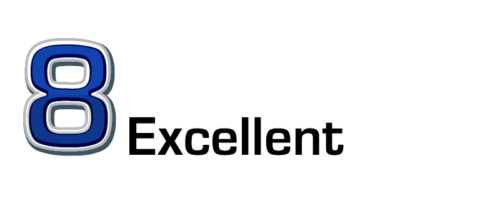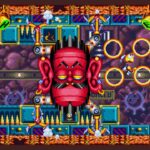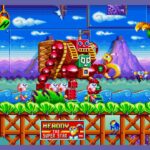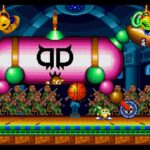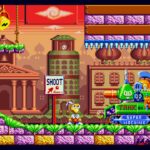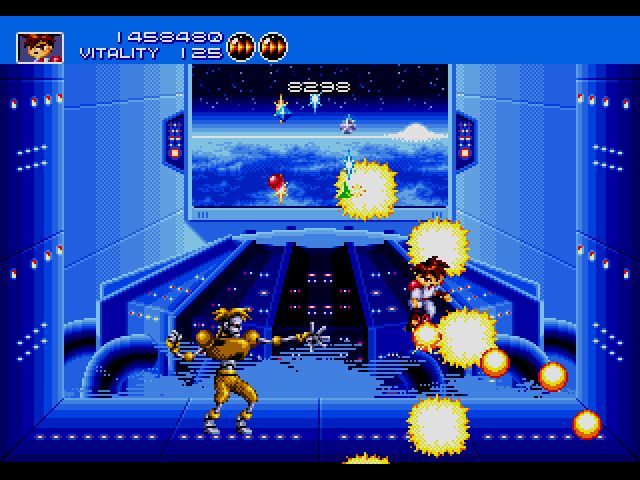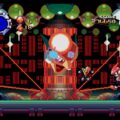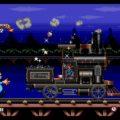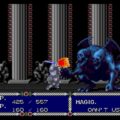Developer: Treasure Publisher: Sega Release 09/94 Genre: Action
To this day I am still amazed at the hit streak developer Treasure were on with the Sega Genesis. Their first release, Gunstar Heroes, is one of the top ten greatest games for the system in my opinion but they did not stop there. Every subsequent release was a festival of technical brilliance and innovative mechanics. For God’s sake they made a pretty awesome McDonalds game! Dynamite Headdy is one of their stranger titles and one that I have only warmed up to recently. It is a bit strange but no less incredible than their other titles and deserves a higher profile.
Right off the bat Dynamite Headdy is immediately visually striking. The entire game uses a theater aesthetic with stage props, lights, and cutaways lining each environment. This allows the game to visit any setting as it is essentially a stage play. The game’s use of the system’s limited color palette defies the hardware making it one of the most vibrant on the Genesis. Even though there is no dialogue characters are imbued with enough personality it is not necessary. This goes for Headdy himself to even the bosses. And as you would expect from Treasure it is a festival of special effects. The spectacle can get in the way of gameplay at times (Backstage Battle specifically) but otherwise this is another showcase of what the Genesis can do.
Dynamite Headdy borrows a bit from McDonald’s Treasureland Adventure. As you might have guessed your head is the primary weapon. It can be sent flying in eight directions to attack enemies and grab objects and platforms. On its own it is not very strong. But the Headdy in the title means your head is interchangeable which grant many different powers. The Protector Head grants a spinning shield for a brief time. Spike head lets you stick to ceilings and walls. The empty head makes you invincible from most damage outside of spikes or pits. Some let you fly or vacuum enemies. Not everything is beneficial. The sleepy head regains health but you are asleep, leaving you vulnerable. Head Trip makes you so heavy you can barely move. With eighteen heads there is more variety than some entire series of games.
The various heads and there integration in the game is what makes Dynamite Headdy so great. Throughout each stage there is often an item roulette that offers a choice of three or four heads. Each allows you to tackle the level differently with some paths varying in their difficulty. The level design all around is generally fantastic and endlessly creative in their use of the various power-ups. Many are situational such as pin head which shrinks you down to squeeze through tight passages. Others are level specific. Level six is one long shooter stage broken into multiple parts. There are three heads unique to this stage and it is surprising how well the game adapts to being a shooter. Or maybe not considering their later work in the genre.
My one main criticism is that I wish the head power-ups lasted longer. I understand the brief window on certain abilities: stopping time could be game breaking if it were longer. But in many instances it feels just as you are enjoying a particular ability it goes away. Because of this the game is mostly designed around the default head, as it should. With so many fantastical abilities it is deflating that some of the better powers are so rare. Dynamite Headdy has almost as many bosses as Gunstar Heroes and they are just as creative in their design and powers. They take full advantage of the game’s stage play theme and were it not for Alien Soldier would possibly be my favorite set of Treasure bosses. Unfortunately these boss battles suffer due to the game’s challenge.
Dynamite Headdy will frustrate many because of its high difficulty. The western release is more difficult than the Japanese version in numerous ways. You begin with no continues and must collect thirteen pieces of the key master to earn them. This is not easy and considering how long the game is (nine levels with plenty of sub-stages) it is a massive oversight, especially as the original gives you two. Health power-ups are rare and with the frequent boss battles there is little room for error. Unfortunately the bosses have twice as much health as in the Japanese version making them a long slog at times. Normally I enjoy the challenge of learning the boss patterns in Treasure games. But here because the difficulty is so high I began to dread each encounter. It does not ruin the game of course but the changes do hurt it.
In Closing
Dynamite Headdy is a fantastic game that suffered due to a packed release schedule. If there were any justice it would have received the same level of attention as Sega’s other titles that fall like Sonic & Knuckles but such is life. If fun mechanics, insane production values, and a lengthy quest are what you seek Dynamite Headdy is right up your alley.
